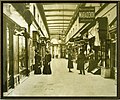Passage of the panorama
| Passage of the panorama | |
|---|---|
| location | |
| Arrondissement | 2. |
| quarter | Vivienne |
| Beginning | 10, rue Saint-Marc |
| The End | 11, Boulevard Montmartre |
| morphology | |
| length | 133 m |
| width | 3.2 |
| history | |
| Emergence | 1800 |
| Coding | |
| Paris | 6940 |
The Passage des Panoramas is a covered shopping arcade in Paris in the 2nd arrondissement , between Boulevard Montmartre in the north and Rue Saint-Martin in the south. The passage is an important address for philatelists .
Situation and access
The passage is one of the oldest in Paris and one of the first covered shopping streets in Europe. It was added to the list of Monument historique on July 7, 1974 .
The Grands Boulevards metro station is nearby.
Name origin
The name was given to the passage because originally there was actually panorama painting .
history
The passage was built in 1799/1800 on the site of the Hôtel de Montmorency-Luxembourg , which was built by Lassurance in 1704 . Today's entrance on Rue Saint-Marc, across from Rue des Panoramas, was the front door to this house. The name comes from a commercial attraction that belonged to the American engineer and inventor Robert Fulton who came to Paris to offer his latest inventions, the steamship, the submarine and torpedoes, Napoleon and the Directoire . While waiting for the answer, Fulton subsidized his Nautilus project with the money he made from a commercial exhibition that was installed above the entrance and consisted of two rotundas, the panoramic images of landscapes from Paris, Toulon, Rome, and Jerusalem other famous cities represented. When Napoléon rejected Fulton's project, the latter left his panoramas to offer his invention to the English in London.
When the American shipowner James William Thayer bought the old hotel at auction, he found a means of making the place profitable through this attraction. It was also he who had the first section of the passage, which was named «Panoramas», in memory of the panorama pictures destroyed in 1831.

The first covered gallery was opened in the Palais Royal in 1786 , followed by the Feydau Passage in 1790-1791, the Cairo Passage in 1799 and the Panorama Passage in 1800. In 1800, shopping was in the dark, muddy and crowded streets of Paris, very few of which had sidewalks or lighting, uncomfortable. For centuries, bazaars and eastern souks had covered shopping arcades. But the Panorama Passage was first fitted with glass roofs and then, in 1816, the first gas lighting invented by engineer Philippe Lebon was installed on a trial basis in this passage . Thus the passage became an ancestor of shopping malls of the 19th century and of covered shopping malls of the 20th century.
In 1834 the architect Grisart renovated the passage and created three additional galleries inside the block: Galerie Saint-Marc, parallel to the passage; Galerie des Variétés, which is also the entrance to the Théâtre des Variétés ; Feydeau et Montmartre Gallery. The engraver Stern and dealers in (art) postcards and stamps , as well as some restaurants , settle here . Today, the passage near Boulevard Montmartre is richly decorated, while the more distant galleries appear neglected.
In the 19th century, the sculptor Jean-Pierre Dantan exhibited his small plaster or bronze busts, caricatures and portraits of the society of that time (including Talleyrand , Louis-Philippe , Beethoven , Paganini , Liszt , Victor Hugo , Balzac ) in one of the Dantan museums »Known rooms.
The Passage des Panoras inspired the “Cour de Paris”, a shopping center on the ground floor of the Brudern Haus in Budapest . The Musée Carnavalet shows a watercolor by Georges Cain , the Le Passage des panoramas (époque du Consulat) où fut fondée la maison Susse frères . In Chapter VII of Émile Zola's novel Nana , the passage describes what it looked like in 1867. Even Anne Cuneo in 1978 created a novel in the passage.
Views
On the left the Théâtre des Variétés and on the right the two rotundas by James W. Thayer with the entrance to the passage.
Entrance on Boulevard Montmartre .
Entrance on Rue Montmartre .
literature
- Andrew Ayers, The Architecture of Paris: An Architectural Guide , Stuttgart / Londres, Axel Menges, 2004, 415 pp., ISBN 978-3-93069-896-7
- Alfred Fierro, La Vie des Parisiens sous Napoléon , Saint-Cloud, Napoléon Ier éditions, 2003, 346 pages, ISBN 978-2-95195-390-1
- Jacques Hillairet, Connaissance du Vieux Paris , Paris, Rivages, 2001, ISBN 978-2-86930-648-6
Web links
- The passage on: www.insecula.com/
Individual evidence
- ↑ Read the original text on the page www2.culture.gouv.fr/ , Base Mérimée , French Ministry of Culture and Communication .
- ↑ L'Intermédiaire des chercheurs et curieux , Paris, Benjamin Duprat, 1928, 373 pages.
- ^ A b Don Herweck, Robert Fulton: Engineer of the Steamboat , Minneapolis, Compass Point Books, 2008, ISBN 978-0-75653-961-0 ; P. 17
- ^ Jacques Hillairet, Connaissance du Vieux Paris , Paris, Rivages, 2001, ISBN 978-2-86930-648-6 , 244 pp.
- ↑ a b Erkki Huhtamo, Illusions in Motion: Media Archeology of the Moving , Cambridge, Massachusetts Institute of Technology, 2013, 438 pp., ISBN 978-0-26231-309-4
- ^ Alfred Fierro, La Vie des Parisiens sous Napoléon , Saint-Cloud, Napoléon Ier éditions, 2003, 346 pages, ISBN 978-2-95195-390-1
- ^ Andrew Ayers, The Architecture of Paris: An Architectural Guide , Stuttgart / Londres, Axel Menges, 2004, 415 pp., ISBN 978-3-93069-896-7
- ↑ This is one of the oldest engraving and printing companies in Paris. ( fr: engraver star )
- ↑ This shop is also registered as a Monument historique .
Coordinates: 48 ° 52 ′ 16 ″ N , 2 ° 20 ′ 30 ″ E










